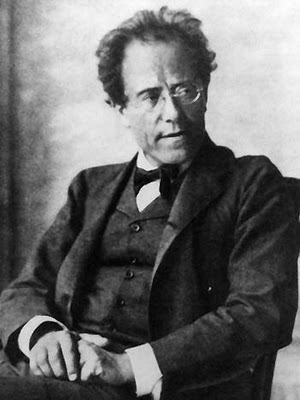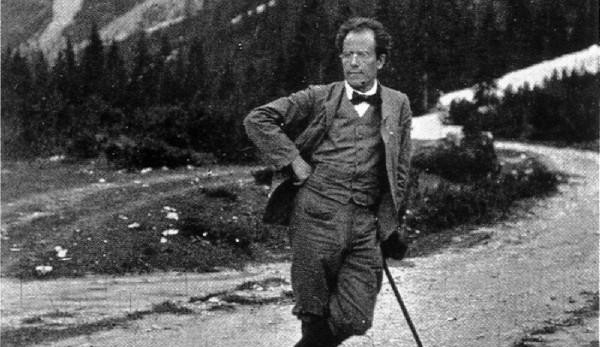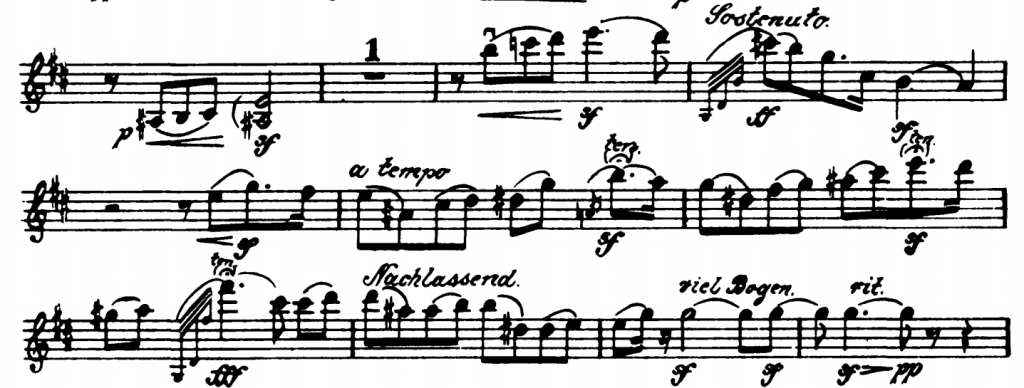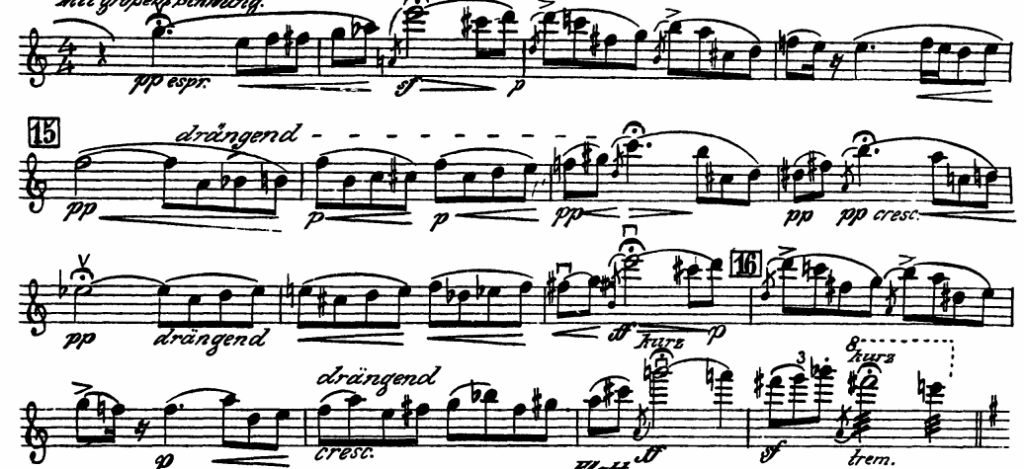Ken’s first summer at Colorado MahlerFest is just around the corner, and so it seems time to add to the Mahler- A Performer’s Perspective library here at Vftp.
This year’s festival centers on Mahler’s 7th Symphony with performances on the 21st and 22nd of May. Festival details and booking information are here.
 Gustav Mahler may well have been the first composer to end each of his symphonies with the postscript “to be continued…”
Gustav Mahler may well have been the first composer to end each of his symphonies with the postscript “to be continued…”
He himself said the funeral march which opens his Second Symphony was a memorial service for the hero of his First Symphony. His Third Symphony is full of hints of the gentle song, Das himmlische Leben, which would later conclude his Fourth. Almost all of the thematic material in his Fifth is drawn from the famous opening trumpet fanfare- a fanfare heard for the first time in the opening movement of this Fourth Symphony. And his Sixth Symphony seems clearly to have emerged from the rubble left behind in the wake of the cataclysm which is the second movement of the Fifth Symphony. Of all the Mahler symphonies, I think the Sixth is the one that ends in the most definitive way. After all, how can you have a story that is “to be continued…” when all of the major characters have been brutally killed off?
I’ve written before about the parallels between the Second and Sixth Mahler symphonies. In both cases, there is a pretty clear narrative of heroic striving against seemingly insurmountable obstacles. In the case of the Second, just when all seems lost (and the world literally comes to an end), there is a moment of divine intervention and everything turns out great. In the Sixth, instead of the benevolent hand of a merciful God delivering mercy in humanity’s hour of need, we have the cold hand (or hammer) Fate, unsentimentally beating our hero into oblivion.
Where then in the narrative of the Sixth Symphony is there room for Mahler’s trademark “to be continued…”?
Well, one doesn’t have to look too hard at the first movement of Mahler 7 to see that it is, very much, a musical continuation of the Sixth. The key alone tells us this. It was no accident that Mahler 6 was in A minor- that was the key of the second movement of the Fifth Symphony from which it grew. The first movement of the Seventh is in E (originally E minor, ending in E major). E is the dominant of A, the key of the Sixth. One would have expected E to have been the second most important key in the Sixth Symphony- after all, it is the dominant which we expect to take us home to the tonic. However, in the Sixth, Mahler undermines the role of the dominant. Rather than arriving in the home key of A minor via the dominant E, he almost always approaches it from what we call the parallel major, A major. Even in a minor key, the dominant-tonic cadence is one of the most galvanizing and cathartic gestures in music. In the Sixth, we don’t cadence into the tonic key from the dominant and exhale a sigh of relief, we collapse into it from the parallel major with a scream of despair. The upshot of this is that the key of E never gets its due in the Sixth Symphony.
And so, in the Seventh, it is if Mahler says to us- “ever wondered what happened to the key of E while the key of A was getting his a$$ kicked in the last episode? Well…..”
On the biggest structural level, the opening movement of Mahler 7 also offers something of a rebuttal to the narrative of Mahler 6. If Mahler was the composer of “to be continued…”, Brahms was the composer of “on the other hand….” Brahms almost always composed in opposing pairs. His Tragic Overture is like a dark mirror image of the jolly Academic Festival Overture- the two pieces were written one after the other. The more definitive the statement he made in one piece, the more urgently he seemed to need to present a counter argument. After his taught, dramatic and Beethovenian First Symphony (which took him seventeen years to write), Brahms answered with his pastoral Second Symphony (written in just months). Perhaps the Seventh is Mahler’s “on the other hand…” work?
The collapse from A major to A minor (or, more generally, from major to minor) is the main generative idea of the Sixth Symphony. In the Seventh, Mahler opens with a movement which, after an introduction which starts in B minor and works its way through a few keys (not unlike the slow introduction with opens the last movement of the Sixth), journeys from E minor to E major.
For most composers, such a journey would not be so unusual- all of Beethoven’s minor key symphonies and concerti end in the parallel major, as does Brahms’ First, Schumann’s Fourth, Dvorak’s Seventh and Schubert’s Fourth. For Mahler, this journey is not unheard of (for instance, the Third Symphony outlines a huge journey from D minor to D major). It is, however, not to be taken for granted. The Second Symphony, in C minor, finds salvation not in C major but in E-flat Major. The Sixth taught us that minor doesn’t have to progress to major. After that harrowing work, Mahler’s listeners could never again take a happy ending for granted. “On the other hand,” in the opening movement of the Seventh, Mahler reminds us that minor can lead to major.
There are other stylistic and thematic similarities between the opening movement of the Seventh and the dark world of the Sixth. The march rhythms which underpin the main material of the movement emerge of the same sort of primordial ooze which opens the Finale of the Sixth, and carry us into a strikingly similar sound world. The second theme of the first movement of the Seventh is cut very much from the same cloth as the second theme of the first movement of the Sixth (the so-called “Alma Theme”). Both have the same temporal “tugs” on the weak beats, and similar flowing quavers carrying the line forward.
In the dark middle section of the first movement of the Seventh, Mahler brings back one of the main themes of the Finale of the Sixth. In the Sixth, it was the hero’s theme, the theme which reaches ecstatically for the stars just before Fate’s hammer crashes down.
In the Seventh, it becomes a funeral dirge.
This movement is one of Mahler’s most astounding musical creations, and yet for all its structural clarity, its power and originality, I find it is neither as dramatic as the Sixth nor as cathartic as the Second. I believe that this is not due to any compositional shortcomings, but is the result of a profound change in narrative perspective from almost all of Mahler’s earlier music. The first movement of the Seventh is a journey where his previous symphonies have been dramas, it is observational rather than participatory. In fact, this change of emphasis is true of the whole Seventh. In each of his earlier symphonies, Mahler makes us keenly aware of the voice of a heroic narrator. In the First, he describes a Romantic hero who must accept death in order to triumph, and that journey is amplified to apocalyptic proportions in the Second. Mahler’s original program for the Third Symphony was as personal as it was poetic- he describes “What Nature Tells Me” rather than “What Nature Tells us.” In the Fourth, our hero is a child, and in the Fifth, Mahler brings us into his inner world by including his declaration of love to Alma, the Adagietto. In the Sixth, the most dramatic, the most personal, the most participatory of them all, the “hero suffers three blows of fate, the last of which fells him as a tree.” To borrow a literary parallel, after writing six symphonies in the first person, for the first time in the Seventh, Mahler is writing in the third person.
Let’s go back to the Adagietto of the Fifth for a moment- it is about Mahler’s love for Alma (although that is by no means the only level of meaning). The fourth movement of the Seventh Symphony is a different kind of love song- the second Nachtmusik is a serenade, complete with guitar and mandolin, but in this movement we sense Mahler describing an archetypical young lover, not barring his own soul nor revealing his love for his soulmate. He is observing the wider human experience, not drawing us into his inner world, except indirectly- sharing his reactions to the experiences of others.
There are even some subtle thematic recollections of the Adagietto in this movement toward the end, freed from all the longing and rendered wistful, affectionate and breezy.
So it is that in the first movement of the Seventh, when we revisit the hero’s music from the Finale of the Sixth, the voice of the hero is tellingly absent. Instead, the sound world, replete with trombone solo, is that of the first movement of the Third Symphony. In the Seventh, Mahler tells us “here nature roars,” just as it does in the first movement of the Third.
I’ve said many times that one can read each of Beethoven’s symphonies as offering a different answer to the question of whether life is worth living or, for that matter, whether it’s worth getting out of bed tomorrow morning. In his first five symphonies, Mahler seems to me to be asking “will everything be alright in the end?” In each of those works, he is able to arrive at a convincing “yes,” but in the Sixth, the answer, for the first time, is an emphatic and unambiguous “no.” That it was his most perfect and powerful work made moving on from this “no” all the more difficult. Perhaps in the Seventh, Mahler is asking us “how do we live with the certainty of uncertainty, how do we live without the promise of salvation or triumph.”
The answer in the Seventh, it seems to me, is that life has a will of its own, a power and a force of its own. So it is that when we remember the hero of the Sixth, it is only the wild, untamed voice of nature that we hear. If one were to make a criticism of the philosophical underpinnings of Mahler’s early symphonies, it would simply be that there might be something a little naïve and simplistic in the Romantic notion that some mixture of heroic striving and divine intervention could guarantee triumph and happiness. The Sixth powerfully illustrates the naivety of trusting in a higher power to intervene on your behalf, and cruelly demonstrates the limits of human agency. It even makes the heroic imagery of the earlier works look just the slightest bit narcissistic. In the Seventh, it seems to me he’s been forced, for the moment, to accept the smallness of the individual, and to recognize the grandeur and the power of nature, and the messiness of life.




Terrific post. Your assertion that the 7th is observational rather than participatory was particularly interesting. There is indeed a certain distance that the 7th has that I think a lot of people find confounding, especially relative to his other works. The second Nachtmusik and finale in particular, to me, at least walk in the general direction of the line that crosses into parody, an expression of what we all think love and happiness is. I think the 7th is the most satisfying of Mahler’s symphonies to just listen to. You don’t need stories, subtitles, or narratives, just what’s on the page. It’s a God damned marvel.
I’m not sure what your process for developing your performance approach over the coming months may be, but if it ever involves recordings and you haven’t had the chance to hear it yet, make sure you hear Kondrashin/Concertgebouworkest on Tahra. Mind-blowing energy.